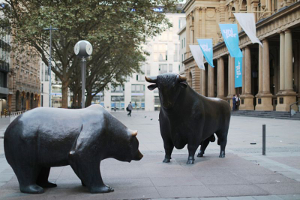|

|

|
|
On This Site
|
|
Share This Page
|
|
|
|
|
|
|
Follow This Site

|
 |
|
|
|
|

|
Why Is It That Bulls and Bears Describe the Stock Market?
The animals bear and bull are commonly used when describing activity on the stock market and even when talking about people who do such activity. How did this come to be?

When stock prices are, in general, going up, this is described as a bull market. By contrast, a trend of prices falling is described as a bear market. As well, a person who believes that stock prices are going to rise is described as "a bull," and a person who believes that stock prices are going to fall id described as "a bear."
Experts have advanced several theories for this through the years. No consensus exists.
Here are the theories:
- It has to do with the animals themselves and the way they attack. A charging bull will employ its horns in an upward motion to attack or to defend itself. A bear, on the other hand, rakes its claws downward to attack or defend.
- In the 17th Century, the London Stock Exchange made frequent use of a bulletin board on which traders posted offers to buy stocks. When demand for stocks was high, the bulletin board would be be full of bulletins, which got shortened to "bulls." When demand for stocks was low, the bulletin board would have relatively few bulletins and so could be described as "bare." The latter is a homonym for bear the animal, of course, but these terms were used, without reference to the animals in question.
- One common phrase in the 16th Century was "Don't sell the bear's skin before you've killed him." A modern version of this might be "Don't count your chickens before they've hatched." The idea is the same: Wait to be sure before you commit to something. It was regular practice at that time for a salesman to find buyers for bearskins and complete the sell before the salesman had the bearskins in his possession. He made the sale based on anticipated demand. The idea for the salesman was to sell the bearskin at a higher price than what he paid. Such an idea is sound economic practice; completing the sale before having possession of what is being sold is called short selling. This kind of thing went on, and salesmen who did it were called "bearskin jobbers." The bull doesn't appear in this theory.
The terms were commonplace in the American stock market setting in the 19th Century. After one particular devastating stock market crash, in 1873, the artist William Holbrook Beard depicted the distress using bulls and bears.
Have a suggestion for this feature? Email Dave.
|
Social Studies for Kids
copyright 2002–2023
David White |






